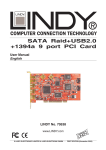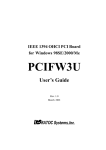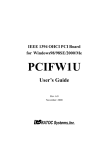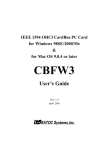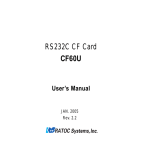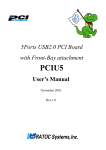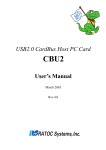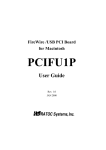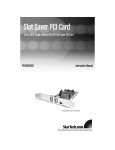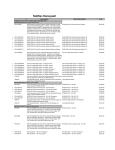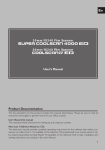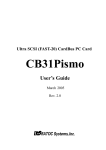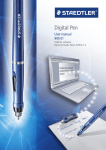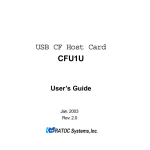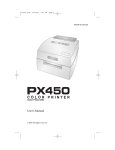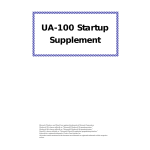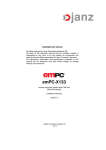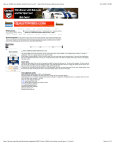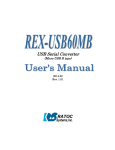Download PCIFU1U User`s guide
Transcript
IEEE 1394/USB Combo PCI Board for Windows98SE/2000/Me PCIFU1U User’s Guide Rev. 1.0 November 2000 PCIFU1U User's Guide 1. Introduction........................................................................... 1 1-1. Package Confirmation 1-2. System Requirements 1 1 2. Hardware Setup .................................................................... 2 2-1. PCIFU1U Board 2-2. Installing the PCIFU1U into a PCI slot 2 3 3. Installing Driver .................................................................... 4 3-1. Windows 98 SE Installation 3-2. Windows 2000 Installation 3-3. Windows Me Installation 4 13 15 4. Setup RsDvCap.................................................................... 18 4-1. Installing RsDvCap/RsDvStill/CompressAVI 4-2. Installing MSDV update for Windows98 SE only 18 20 5. How to use RsDvCap .......................................................... 21 5-1. Main menu 5-2. Control Bars 5-2-1. Camera and Audio Select Bar 5-2-2. Camera Control Bar 5-2-3. Video Control Bar 5-3. Application settings 5-4. Capturing a video from a DVCAM in camera mode 5-5. Capturing a video from a DV tape 5-6. DV Batch Capture 5-7. Exporting a video to a DVCAM 22 23 23 23 24 25 29 30 31 33 6. How to use RsDvStill .......................................................... 34 6-1. Main menu 6-2. How to save a BMP file 34 37 7. How to use CompressAVI ................................................... 39 7-1. How to convert the MS DV-AVI2 format into other formats? 7-2. How to convert other formats to the MS DV-AVI2 format? 40 44 8.Ulead Video Studio .............................................................. 47 9.Registration and Tech-Support........................................... 48 9-1. How to Register 9-2. Software Update and Support 48 48 10.Specifications ...................................................................... 49 1. Introduction This User Guide describes how to install, use, and troubleshoot the RATOC 1394 USB Combo PCI Board (called PCIFU1U in this User’s Guide). The information in the README.TXT file on the CD-ROM may include the latest information. Be sure to read the README.TXT file as well. 1-1. Package Confirmation Confirm the package contents: • PCIFU1 1394 USB Combo PCI Board • DV 4p-1394 6p cable • HDD power connector extend cable • PCIFU1U capture software(CD-ROM) • Ulead Video Studio 4.0 SE Basic(CD-ROM) • User’s Guide (This document) • Software License Agreement NOTE If any of these items are missing from the PCIFU1U retail package, contact your supplier immediately. 1-2. System Requirements Your PC must meet the following requirements: •One free PCI slot •Windows98 SE(Second Edition)/Windows2000/Windows Me(Millennium Edition) •Pentium II 300MHz or faster for video editing •At least 64 MB memory for video editing •High performance AGP Graphic Board for video editing •High performance Sound Board for video editing •High performance DMA enabled Hard Disk Drive for video editing •Sufficient Hard Disk space for video capture (1 second DV video = 3.6MB) for video editing 1 2. Hardware Setup 2-1.PCIFU1U Board Before installing the PCIFU1U into a PCI slot, understand the usage of the connectors on the PCIFU1U. U12 U14 U17 U9 U7,U9 U17,U14 2 J2 U7 1394 6pin external connector USB type A connector U12 1394 6pin internal connector J2 1394 Cable Power connector You have to connect this J2 to a HDD power connector of your PC to use cable-powered device such as 1394 portable HDD,CCD camera,etc. 2-2.Installing the PCIFU1U into a PCI slot Follow the steps through to install the PCIFU1U into a PCI slot. 1.Turn off your PC and remove the computer cover. 2.Carefully install the PCIFU1U by firmly pressing the PCI board into a PCI expansion slot. 3.Fasten the retaining bracket with the screw. 4.Extend a HDD power connector of your PC with the HDD power connector extend cable in this package and connect it to the J2 connector on the PCIFU1U. You have to connect this cable to use cable-powered type 1394 devices such as portable HDDs, CCD cameras those require cable power source. 5.Attach the computer cover. 3 3. Installing Driver Windows98SE This section describes the driver installation. First, confirm your Windows version. When your Windows version is Windows 98 SE(Second Edition), go to Chapter 3-1. When your Windows version is Windows 2000, go to Chapter 3-2. When your Windows version is Windows Me(Millennium Edition), go to Chapter 3-3. 3-1.Windows 98 SE Installation To use the PCIFU1U on Windows 98 Second Edition, follow the steps through. Make sure your Windows is Windows98 Second Edition by checking the “Properties” of “My Computer”. If you can find “Second Edition”, you have Windows98 Second Edition. 4 Step 1. Installing Driver 1.Start the PC. Hardware Wizard will detect the PCIFU1U automatically and you will see the screen below. Click [Next]. Windows98SE 2.You will see the screen below. Select [Search for the best driver for your device (Recommeded)] and click [Next]. 3.You will see the screen below. You don’t need to check any boxes. Click [Next]. 5 Windows98SE 4.You will see the screen below. Click [Next]. 5.You will see the screen below. Click [Finish]. 6.Next, you will see the screen below. Click [Next]. 6 7.You will see the screen below. Select [Search for the best driver for your device (Recommeded)] and click [Next]. Windows98SE 8.You will see the screen below. You don’t need to check any boxes. Click [Next]. 9.You will see the screen below. Select [The updated driver (Recommended) NEC Firewarden OHCI Compliant IEEE 1394 Host Controller]. Then click [Next]. 7 Windows98SE 10. You will see the screen below. Click [Next]. 11.When the following window appears, insert the Windows 98 SE CD-ROM into the CD-ROM drive. Then click [OK]. 12.If the following window appears, type “D:\Win98” or “C:\Windows\options\cabs” in the Copy files from box, where “D” means the CD-ROM drive. After that, click [OK]. If your CD-ROM drive is not “D”, you must replace “D” to the appropriate drive name. 8 13.You will see the screen below. Click [Finish]. You have now completed the installation of the driver. Windows98SE 9 Step 2. Confirming the Installation of the Driver To confirm the driver installation, follow the steps through. 1.Click My Computer with the right button of the mouse. Windows98SE 2.Select Properties. 3.Click the Device Manager tab. 4.a)Confirm there is a NEC Firewarden OHCI Compliant IEEE 1394 Host Controller string without any yellow “!” marks or red “X” marks under the 1394 Bus Controller. 10 b)Confirm there is a PCI standard PCI-to-PCI bridge string without any yellow “!” marks or red “X” marks under the System devices. Windows98SE c)Confirm there is a NEC USB Open Host Controller or OPTi 82C861 PCI to USB Open Host Controller string without any yellow “!” marks or red “X” marks under the Universal Serial Bus controllers. 11 Step3.Microsoft Windows Update You should update your Windows 98 SE to improve performance. To update your Windows 98 SE, follow the steps through. 1.Click Start with the left button of the mouse. Windows98SE 2.Select Windows Update. 3.You will see the screen below. Click PRODUCT UPDATES. 4.You will see the screen below.Check Windows 98 Second Edition 1394 Storage Supplement and download the component. For more information on the component, refer to Read this first on the screen. 12 3-2.Windows 2000 Installation To use the PCIFU1U on Windows 2000, follow the steps through. Confirming the Installation of the Driver When you start the PC, the driver is installed automatically by the Hardware Wizard. To confirm the driver Installation, follow the steps through. 1.Click My Computer with the right button of the mouse. 2.Select Properties. 4.Click the “Device Manager” button. Windows2000 3.You will see the screen below. Click the Hardware tab. 13 5.a)Confirm there is a NEC OHCI Compliant IEEE 1394 Host Controller string without any yellow “!” marks or red “X” marks under the IEEE 1394 Bus host controllers. b)Confirm there is a PCI standard PCI-to-PCI bridge string without any yellow “!” marks or red “X” marks under the System devices. c)Confirm there is a NEC PCI to USB Open Host Controller or OPTi 82C861 PCI to USB Open Host Controller string without any yellow “!” marks or red “X” marks under Windows2000 the Universal Serial Bus controllers. 14 3-3.Windows Me Installation To use the PCIFU1U on Windows Me, follow the steps through. Step 1. Installing Driver 1.Start the PC. Hardware Wizard will detect the PCIFU1U automatically and you will see the screen below. Select [Automatic search for a better driver(Recommended)] and click [Next]. Windows Me 2.You will see the screen below. Click [Finish]. 15 Step 2. Confirming the Installation of the Driver To confirm the driver Installation, follow the steps through. 1.Click My Computer with the right button of the mouse. 2.Select Properties. 3.You will see the screen below. Click the Device Manager tab. 4.a)Confirm there is a NEC Firewarden OHCI Compliant IEEE 1394 Host Controller string Windows Me without any yellow “!” marks or red “X” marks under the 1394 Bus Controller. b)Confirm there is a PCI standard PCI-to-PCI bridge string without any yellow “!” marks or red “X” marks under the System devices. 16 c)Confirm there is a NEC USB Open Host Controller or OPTi 82C861 PCI to USB Open Host Controller string without any yellow “!” marks or red “X” marks under the Universal Serial Bus controllers. Windows Me 17 4. Setup RsDvCap 4-1.Installing RsDvCap/RsDvStill/CompressAVI 1.Close all programs currently running on your computer. 2.Set the RATOC 1394 USB Combo PCI Board CD-ROM in your CD-ROM drive. 3.Open [My Computer] and double-click CD-ROM drive icon. 4.Open [Win98SE], [Win2000] or [WinMe] folder. If your Windows version is Windows98 SE(Second Edition), open [Win98SE] folder. If your Windows version is Windows2000, open [Win2000] folder. If your Windows version is Windows ME(Millennium Edition), open [WinMe] folder. 5.Double-click the [RsDvCap] folder. 6.Double-click on [Setup.exe] to install the RsDvCap software. 7.You will see the screen below.Click [Next]. 18 8.You will see the screen below. Click [Next]. 9.You will see the screen below. Click [Next]. 19 10.You will see the screen below. Select [Yes, I want to restart my computer now] and click [Finish]. You have now completed installing the capture software. 4-2.Installing MSDV update for Windows98 SE only Install MSDV update program(252640USA8.EXE) only when you use Windows98 SE(Second Edition). If you use Windows2000 or Windows ME(Millennium Edition), skip this installation of MSDV update program. Follow steps through to install MSDV update program. 1.Set the RATOC 1394 USB Combo PCI Board CD-ROM into your CD-ROM drive. 2.Open [My Computer] and double-click CD-ROM drive icon. 3.Double-click [Win98se] folder and double-click the [DvPatch] folder. 4.Double-click on [252640USA8.EXE]. 20 5. How to use RsDvCap What is the RsDvCap? This application software has the following functions. •Preview and capture video/sound data from a DVCAM. •Preview and capture video data from a CCD camera. •Export media file from a PC to a DVCAM. •Playback media file. Main menu Camera Control Bar Camera and Audio Select Bar Batch Capture List Bar Video Control Bar RsDvCap Main Screen NOTE 1.This software uses Microsoft standard DV-AVI2 format video file. 2.To capture correct DV file, you have to use original DV footages which has continuous Timecode(recording). If the original DV footage has intermittent Timecode, sometimes it may cause system freeze or may not be captured. 21 5-1.Main menu: Top menu File Setting View Sub menu Review movie file Select an AVI file you want to play back. END Terminate this application. DV Batch Capture Show batch capture dialog box.Refer to 5-6.DV Batch Capture. Application Setting Show RsDvCap parameter setting dialog box. Refer to 5-3.Application settings. Cam Setting Show CCD camera control dialog box. Camera Audio Select Bar Show Camera and Audio Select Bar. Refer to 5-2-1.Camera and Audio Select Bar. Camera Control Bar Display 22 Description Show the DVCAM camera mode control bar. You can control a DVCAM.Refer to 5-2-2. Camera Control Bar. Video Control Bar Show the DVCAM video mode control bar. You can control a DVCAM.Refer to 5-2-3. Video Control Bar. Batch Capture List Show the Batch Capture List Bar.You can capture favorite scenes in a DV tape to your HDD.Refer to 5-6.DV Batch Capture. Select the size of the preview window. The preview window of the [PC] is 4:3. The preview window of the [DV] is 3:2. 5-2.Control Bars 5-2-1.Camera and Audio Select Bar: Camera list box Sound device list box This bar has the Camera list box and Sound device list box as shown above. Camera list box displays a list of camera device connected to your PC. If this list box is blank, your camera isn't recognized. “Microsoft DV Camera and VCR” string will appear. Sound device list box displays a list of sound device. 5-2-2.Camera Control Bar : You can preview and capture a video image from the connected DVCAM. The bar will appear automatically when the DVCAM is set to camera mode. The DVCAM have a switch which selects video mode or camera mode. Set this switch to camera mode to preview and capture a video image. .....When you click this button, you can preview a video image. .....When you click this button, you can pause a video image. .....When you click this button, you can capture a video image to the HDD. .....When you click this button, you can stop previewing or capturing a video image. .....When you click this button, you will see the Help contents. .....When you click this button, you can play back an AVI file. 23 5-2-3.Video Control Bar : You can control a DVCAM from this control bar. The DVCAM have a switch which select video mode or camera mode. If you set this switch to camera mode or a DV tape is not inserted, this control bar will be disabled automatically. Set this switch to video mode to control the DVCAM. The functions are below: ...Rewind ...Previous frame ...Play ...Next frame ...Pause ...Stop ...Fast forward ...Record ...Pause recording When you click the Capture Now button, you can start to capture DV data from a DVCAM. The [Capture Now] will change to [Capture Stop]. When you click the DV Export button, you can export DV data to a DVCAM.You can see the DV data on the screen of the DVCAM. 1.If you don’t want to record DV data onto your DV tape, don’t check “Record on the tape”. 2.If you really want to record DV data onto your DV tape, check “Record on the tape”. , 24 5-3.Application settings When you select [Application setting] of the [Setting] menu, you will see the dialog box below. You can set up this application’s behavior. 25 Category Item Camera Mode CCD Mode Select when you use a CCD camera. DV Mode Select when you use a DVCAM. Display TimeCode If checked, timecode will be displayed. Preview Settings DV Codec Resolution Description You can select DV Codec Resolution. If you select a higher resolution, you will get a better image. This DV Codec Resolution affects only the preview quality. Capture Settings Capture With Preview If checked, video images will be displayed in the preview window during capturing video stream. When you check here, it will be a heavy load on your PC. If you have problems of dropping frames or sounds, don’t check this option. Rename file name If checked, every time you start and stop every capture execution capturing a video, the file rename dialogbox will appear. You can set a file name and location to save the file in. If you don’t check here, a captured file will be saved automatically under the name of CAPTIME+(Time) +Year+(Date).AVI in the folder you set at “Set Folder Name To Save Capture Files”. 26 Category Item DVCAM Settings Check DVCAM Mode Enable Step Control By Mouse Wheel Description If you click here, this application will detect whether your DVCAM is in camera mode or video mode automatically. If your DVCAM is in video mode, the Camera Control Bar will disappear. If your DVCAM is in camera mode, the Camera Control Bar will appear and the Video Control Bar will be disabled. If you check here, you can control a camera with your mouse as shown below. 1)When you click wheel, a DVCAM starts to play. 2)When you turn wheel down, a DVCAM starts to rewind. 3)When you turn wheel up, a DVCAM starts to fast forward. 4)When you click the right button, a DVCAM stops. 27 CCategory 28 Item Description DVCAM Command Response time When you control a DVCAM from the PC consecutively, it takes some time for the DVCAM to get ready for a next command from the PC. This time depends on the DVCAM. If you have trouble in controlling the DVCAM from the PC consecutively, change this value to a longer time than 4 seconds. Default time is 4 seconds. For example, 5 seconds. DV Export prefix time When you export an AVI file to a DVCAM, there is data prefix time from starting to export the AVI file to recording it onto a DV tape. The data prefix time results in failing to record the beginning of the AVI file onto the DV tape. To avoid this problem, you can set a time here. During the time you set here, blank data will be exported to the DVCAM and it avoids failing to record the beginning of the AVI file onto the DV tape. 5-4.Capturing a video from a DVCAM in camera mode When you want to capture a video image from a DVCAM set to camera mode, follow steps through. 1. Confirm a DVCAM is set to camera mode. Camera mode means you can capture a video image. If your DVCAM is in video mode, change mode selection switch from video mode to camera mode slowly. Everytime you change DVCAM’s Mode Control switch, move this switch to OFF position and confirm that the RsDvCap’s Camera device name will disappear. After that, you can change this switch to your choice and the camera device name will appear. 2. Select [DV mode] on the [Application Setting] as shown in 5-3.Application settings. 3. Click the will appear. 4. Click the 5.Click the button on the Camera Control bar. A video image from a DVCAM button to start capturing. button to stop capturing. You can also stop capturing by using the pressing ESC button on the keyboard. button on the Camera Control Bar or 6. If you checked [Rename file name every capture execution] on the [Application Setting], You will see the window.You can rename the captured file. 7.The file will be saved in the folder you set at [Set Folder Name To Save Capture Files] on the [Application Setting]. NOTE When you preview, it puts some load on PCs. If data loss happens, don't check [Capture With Preview] on the [Application Setting]. 29 5-5.Capturing a video from a DV tape When you want to capture a video image from a DV tape, follow steps through. 1. Set a DV tape in a DVCAM and confirm the DVCAM mode is set to video mode. Video Mode means you can control a video of a DV tape. If your DVCAM is in camera mode, change mode selection switch from camera mode to video mode slowly as mentioned 5-4.Capturing a video from a DVCAM in camera mode. 2.Select [DV mode] on the [Application Setting] as shown in 5-3.Application settings. 3.When you click the DV play button on the Video Control Bar, the DV tape will start to play and a video image of the DV tape will appear in the preview window. 4.Click the button to start capturing. 5.Click the button to stop capturing. You can also stop capturing by using the pressing ESC button on the keyboard. stop button on the Video Control Bar or 6. If you checked [Rename file name every capture execution] on the [Application Setting], You will see the window.You can rename the captured file. 7.The file will be saved in the folder you set at [Set Folder Name To Save Capture Files] on the [Application Setting]. NOTE 1.When you preview, it puts some load on PCs. If data loss happens, don't check [Capture With Preview] on the [Application Setting]. 2.To capture correct DV file, you have to use original DV footages which has continuous Timecode(recording). If the original DV footage has intermittent Time code, sometimes it may cause system freeze or may not be captured. 30 5-6.DV Batch Capture Batch capture function saves video images files as your time scheduling. To batch capture video images from a DV tape, follow steps through. 1.To show the Batch Capture Window as shown right, select [Batch Capture List] of the [View] in the system menu. 2.Set a DV tape in a DVCAM and confirm the DVCAM mode is set to video mode. Video Mode means you can control a video of a DV tape. If your DVCAM is in camera mode,change mode selection switch from camera mode to video mode slowly as mentioned 5-4.Capturing a video from a DVCAM in camera mode. 3. Click the DV play button on the Video Control Bar to play the DV tape. 4. Click the capturing. In point button when you want to start 5. Click the capturing. Out point button when you want to stop 6. Click the Add button to add time code to the window as shown above. To capture other Video images of the DV tape, repeat the steps from 4 to 6. 7.Click the start button to show the Batch Capture dialog box as shown in the next page. 31 8.You will see the screen. Click [OK] to continue. 9. The Batch Capture dialog box will be shown. Click [RUN] to start batch capture.This application searchs automatically the timecode you have just set and starts to capture video images and saves the file in the folder written in the “Export Directory” under the name of Video + (number) starting 1 + .avi as shown below. When batch capture is finished, “Capture Complete!” message will appear.Click [END] to finish batch capture. NOTE To capture correct DV file, you have to use original DV footages which has continuous Timecode(recording). If the original DV footage has intermittent Timecode, sometimes it may cause system freeze or may not be captured. 32 5-7.Exporting a video data to a DVCAM When you want to export an video data to a DVCAM, follow steps through. 1. Set a DVCAM to video mode. Video Mode means you can control a video of a DV tape. If your DVCAM is in camera mode, change mode selection switch from camera mode to video mode slowly as mentioned 5-4.Capturing a video from a DVCAM in camera mode. 2. Click the DV Export button. The File select dialog box will appear. Select an AVI file you want to export, and click [SAVE] button. The AVI data will be exported to the DVCAM. When you check “Record on the tape”, “Video image” and “Rec command” will be sent to the DVCAM. This means the AVI file will be really overwritten to your DV tape. So, you should be careful not to overwrite important DV tapes. When you don’t check “Record on the tape”, only “Video image” will be sent to the DVCAM. This means the AVI file will not be overwritten to your DV tape. You can see the video image on the screen of the DVCAM. NOTE There is time-delay between start of video stream and the DVCAM actually starting to record. So for a few seconds at the head of video stream, nothing will be recorded on your DV tape. 3.Click the stop button in the Camera Control Bar to stop exporting. NOTE Only a Microsoft DV AVI 2.0 with DVSD(Digital Simultaneous Voice and Data) can be exported to a DVCAM. 33 6. How to use RsDvStill What is the RsDvStill? This application software has the following functions. •Preview video data from a DVCAM/a CCD camera. •Save a still image to a BMP file. 6-1.Main menu When RsDvStill starts with a DVCAM connected to the CBFW1U, RsDvStill will detect whether the DVCAM is in camera mode or in video mode automatically and pauses the DV tape if the DVCAM is set to video mode and there is a DV tape in the DVCAM. Preview Window Thumbnail Window SSlider Camera Control Button. NOTE To capture correct DV file, you have to use original DV footages which has continuous Timecode(recording). If the original DV footage has intermittent Timecode, sometimes it may cause system freeze or may not be captured. 34 Category Description DV Maker This list box shows a list of DVCAM manufacturer such as Sony, JVC, Panasonic, Canon, Sharp, etc. Choose your DVCAM manufacturer. If you can’t find it, choose OTHER. Image Size There are 3 kinds of resolution:720 x 480, 360 x 240, 88 x 60. This value means raw data from a DVCAM. Slider Bar You can select a favorite scene from video capture data by moving this slider bar. This slider bar is enabled when you click the Capture button. You can capture video images for about 1 second by clicking this button. After clicking this button, preview will be stopped. You can save a BMP file on the preview window. The BMP file will be saved and hold at the top of the thumbnail window. Video Device Video Device displays a list of camera device connected to your PC. If this list box is blank, your camera isn't recognized. “Microsoft DV Camera and VCR” string will appear. Camera Control Button , When a DVCAM is in video mode, you can control a DV tape as follows. ............Play, Stop .............Pause , .............Fast Rewind, Fast Forward or Slow Rewind, Slow Forward , ..............Previous Frame, Next Frame 35 Category Time Code Description This box shows the timecode information of your DV tape. This timecode format is HOUR:MINUTE:SECOND:FRAME. When you click this button, you will see the screen below. You can select a folder where you want to save a BMP file. This button will be enabled only when you click the button. When you click the button, preview will be paused. When you want to resume previewing, click the button. This button will be enabled only when you use a CCD camera. When you click this button, you can display the CCD camera control dialog box. With this dialog, you can control a CCD camera. For example, zoom, focus, etc. 36 6-2.How to save a BMP file (1)Save a BMP file from a DV tape 1.Set a DV tape in a DVCAM and confirm the DVCAM mode is set to video mode. Video Mode means you can control a video of a DV tape. If the DVCAM is in camera mode, change mode selection switch from camera mode to video mode slowly as mentioned 5-4. Capturing a video from a DVCAM in camera mode. 2.Starting RsDvStill, your DV tape will be paused and the Set DV Maker and decide Image Size. button is disabled. 3.Click the button. You will see the screen below. Select a folder where you want to save a BMP file and click OK. If you don’t select a folder, a BMP file will be saved in the folder where this application is installed. 4. Find a favorite scene on the DV tape, using the camera control button. (TIPS) When the button is disabled, click the button and the button. You can preview slowly. When the button is enabled, click the button. After that,click the button and the button. You can preview slowly. 5.There are two ways to save a BMP file as follows. 5-1.Click the button. The BMP file will be saved in the folder under the name of “Image+ (number) + .BMP” and the BMP file will hold at the top of the thumbnail window. If you double click the thumbnail, you can view it with real BMP file size. 5-2.Click the button. After capturing, the DV tape will be paused. Then move the slider to a favorite scene and click the button. The BMP file will hold as mentioned above. If you want to resume previewing, click the button. 37 (2)Save a BMP file from a DVCAM in camera mode or a CCD camera 1.Set a DVCAM to camera mode. Camera mode means you can capture a video image. If your DVCAM is in video mode, change mode selection switch from video mode to camera mode slowly as mentioned 5-4.Capturing a video from a DVCAM in camera mode. When you use a CCD camera, skip this step. 2.Starting RsDvStill, set DV Maker and decide Image Size. When you use a CCD camera, DV Maker list box is disabled. So, decide Image Size. 3.Click the button. You will see the screen below. Select a folder where you want to save a BMP file. Then click OK. If you don’t select a folder, a BMP file will be saved in the folder where this application is installed. 4.There are two ways to save a BMP file as follows. 4-1.Click the button. The BMP file will be saved in the folder under the name of Image+ (number) + .BMP and the BMP file will hold at the top of the thumbnail window. If you double click the thumbnail, you can view it with real BMP file. 4-2.Click the button. After capturing,preview will be paused. Then move the slider to a favorite scene and click the button. The BMP file will hold as mentioned above. If you want to resume previewing, click the button. NOTE When you use a CCD camera, the button is enabled. Using this button, you can control the CCD camera. For example, zoom, focus, etc. 38 7. How to use CompressAVI What is CompressAVI application software? This application software has the following functions. Convert Microsoft DV-AVI2 format video file to another format video file bi-directionally. As current existent video editing software don't support MS DV-AVI2 format video file, you have to convert the format of video file which is captured by RsDvCap before editing. And after editing, if you want to export it to a DVCAM, you have to re-convert video file to MS DV-AVI2 format video file. Please note, file conversion will take a long time, sometimes over a hour. 39 7-1.How to convert the MS DV-AVI2 format into other formats After you convert the AVI files made by RsDvCap, you can edit it with video editting software. 1.When you start the CompressAVI, you will see the screen below. Click [Execute]. 2.Please select “Convert DV-AVI fomat to other video format” and select Resolution. Click [Next]. 40 3.Please specify an original video file and a converted video file name. Click [Next]. (After conversion, an original video file remains in the HDD.) 4.Please choose a conversion filter from the Compression formats list box. AVI files made by RsDvCap have a compressed data of DV Video format. So, select the other compression formats than DV Video Encorder. 41 There are many kinds of compression formats. (Compression formats appeared in the [Compression formats] list box depend on your system) Popular compression formats are explained below. 1.Microsoft Video1 It does not take much time to convert because this type will lose quality and cause poor image. 2.Microsoft MPEG4 If you use this type of codec, file size will be compressed to about one-tenth and keep good quality. 3.Intel Indeo(R) video3.2 This type of codec was invented by Intel. Compression rate and quality get better than Microsoft Video1 4.Intel Indeo(R) video5 Compression rate will get better under MMX(R) or Pentium(R) II processor. 5.CinePak Codec It takes much time to convert but this type will keep quality. 6.DV Video Encorder This type of codec can capture a video from a DVCAM in real time. RsDvCap uses this type of compression and creates AVI files. 7.Non compression This type saves data without compression. To make data in [Non compression], it is necessary to have Windows98 Second Edition, Windows 2000 or Windows ME. 42 5.Click [Next]. The file conversion starts. It takes much time to convert an AVI file. Conversion time depends on the type of compression format. Please wait patiently. 6.When conversion ends, you will see the screen below. Click [Finish]. You can now do a video editing with your video editting software. 43 7-2.How to convert other formats to the MS DV-AVI2 format? You can export a video to a DVCAM after you convert an existing AVI file to the MS DV-AVI2 format. 1.When you start the CompressAVI, you will see the screen below. Click [Execute]. 2. Please select “Convert other video file format to DV-AVI file format” and and choose NTSC or PAL. NTSC is used in the U.S.A. PAL is used in Europe and Asia(except Japan). Then click [Next]. 44 3.Please specify an orginal video file and a converted video file name. Click [Next]. 4.Click [Next]. It may take much time to convert an AVI file. Please wait patiently. 45 5.When conversion ends, you will see the screen below. Click [Finish]. You can now export the converted data to a DVCAM by using RsDvCap. 46 8.Ulead Video Studio Ulead VideoStudio This software in this package treats MS DV-AVI2 format video file directly and you don't need to convert video files before and after editing. For more information, refer to the Video Studio User’s Manual. Follow the steps below to install Ulead Video Studio. 1.Double click “My Computer”. 2.Insert the Ulead Video Studio CD-ROM and double click your CD-ROM icon. 3.Open “VideoStudio 4.0 SE Basic”. 4.Double-click on the “Setup.exe”. 5.Follow the instructions on the screens. This Ulead Video Studio 4.0 SE has the following new functions. a)Multiple file play back: •You can export DV-AVI2 file more than 2 GBytes onto a DV tape even if your file system is FAT16. •You can export DV-AVI file more than 4 GBytes onto a DV tape even if your file system is FAT32. b)You can capture a still image from a DVCAM. c)You can capture music onto a DV tape and save it as MP3. You can export MP3 onto a DV tape. 47 9. Registration and Tech-Support 9-1. How to Register We highly recommend to register yourself as our customer through our on-line registration. 1. On the Internet, access our site (http://www.ratocsystems.com/english/) 2. Follow window menu guide to register. 3. Fill out and submit the registration form. 9-2. Software Update and Support -Software UpdateThe latest driver and application software are subject to change for improvement or bug fix. You can download the latest version from our web site. (http://www.ratocsystems.com/english/) -Technical SupportYou can get a Tech support from RATOC at the following. (Open Monday - Friday,9:30A.M. to 5:00P.M.(PST)) RATOC Systems International,Inc. Tech support Address: 1933 O’Toole Avenue Suite A109 SanJose, CA 95131, U.S.A. Phone : (408)955-9400 Fax : (408)955-9402 E-mail : [email protected] Web : http://www.ratocsystems.com/english/ NOTE Please include the following information: •Our product name, serial number, and product description •Host Computer Name, Windows version •Application software/driver version 48 10. Specifications • Compliance with 32-bit PCI Local Bus 2.1 • 32-bit PCI bus master DMA transfers up to 132MB/sec in burst mode • USB 1.1 compliant • FullSpeed(12 Mbps) support • IEEE1394-1395,IEEE1394.a compatible PHY chip • 100,200,400 Mbps automatic detect and support • OHCI 1.0 compatible Link chip.Physical DMA support • Two 6p-1394 external ports,One 6p-1394 internal port Two USB 1.1 ports • Class 1(15W) cable power is available through 6p-1394 each port Cable power source is supplied from a internal HD power connector 49 Appendix Trademarks -Windows is a registered trademark of Microsoft Corporation. -Other brand and product names may be registered trademarks or trademarks of their respective holders. Regulatory Agency Notice I)FCC Statement This equipment has been tested and found to comply with the limits for a Class B digital device, pursuant to Part 15 of the FCC Rules. These limits are designed to provide reasonable protection against harmful interference in a residential installation. This equipment generates, uses and can radiate radio frequency energy and, if not installed and used in accordance with the instructions, may cause harmful interference to radio communications. However, there is no guarantee that interference will not occur in a particular installation. If this equipment does cause harmful interference to radio or television reception, which can be determined by turning the equipment off and on, the user is encouraged to try to correct the interference by one or more of the following measures: (1) Reorient or relocate the receiving antenna. (2) Increase the separation between the equipment and receiver. (3) Connect the equipment into an outlet on a circuit different from that to which the receiver is connected. (4) Consult the dealer or an experienced radio/TV technician for help. Changes or modifications not expressly approved by the party responsible for compliance may result in this unit not complying with FCC Rules Part 15. II)CE Statement This device complies with EN55022(class B) and EN50082-1 50 WARNING If you ignore this notice, you risk your own life. You must follow for your personal safety. CAUTION If you ignore this notice, you may be hurt or your system may be damaged. WARNING • Never attempt to disassemble the hardware. Also,never bend,drop,damage or subject the hardware to heavy pressure. • If you use the wet hardware with water, medicines, or oils, etc., you risk having struck by an electric shock or causing a fire. CAUTION • Never subject this product to static electricity because this product is electronic appliance. • Keep this product away from devices which generate noise such as a radio, television set, audio appliance or motor in order to avoid to fail to work. •Do not keep this product in the following places: -High temparature and humidity -Places where temparature changes intensely -Places exposed to extreme dust -Places where vibrations or shocks occur -Places subject to devices with magnetic influence such as a magnet, speaker boxex, and television sets. •This product is not meant to be used for equipments/appliances related to human life or high level reliability such as medical appliances, atomic appliances, aerospace appliances, or transportation appliances. If you equip this product with those appliances and cause you a life or fire accident, we will not be liable to you.






















































